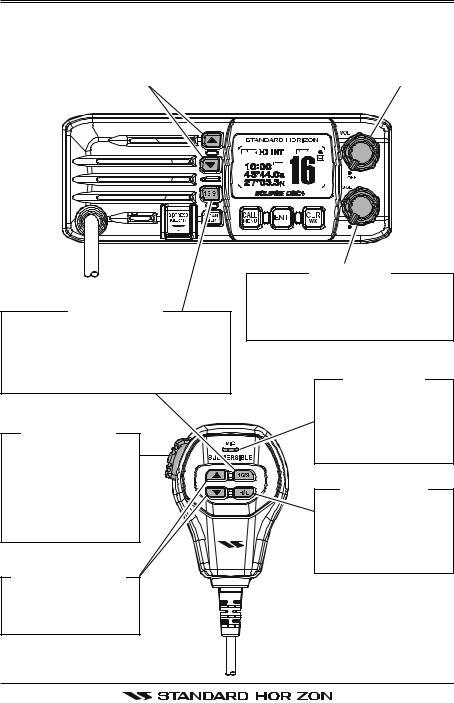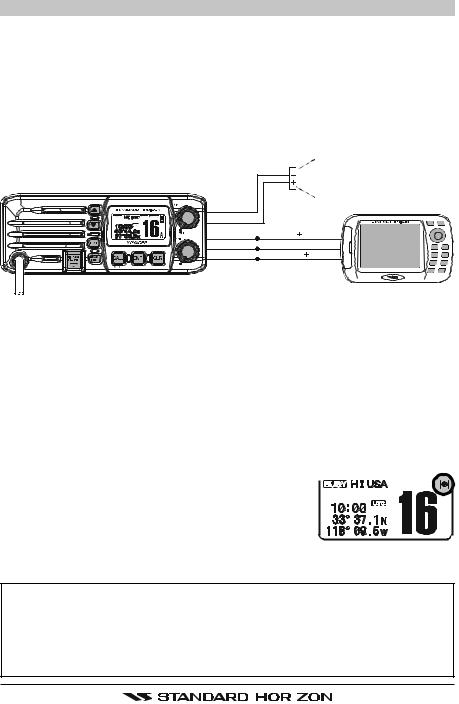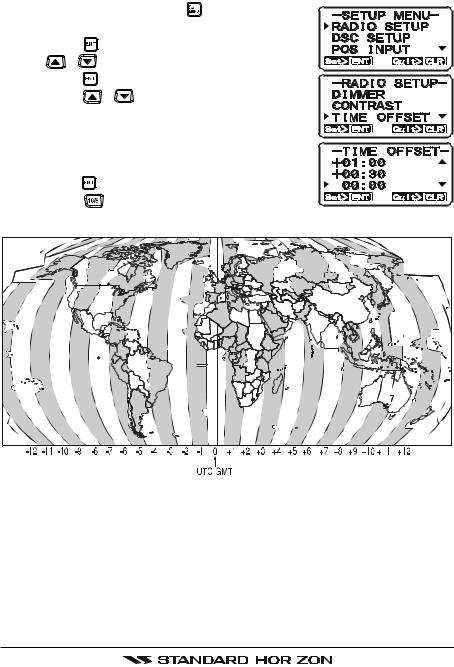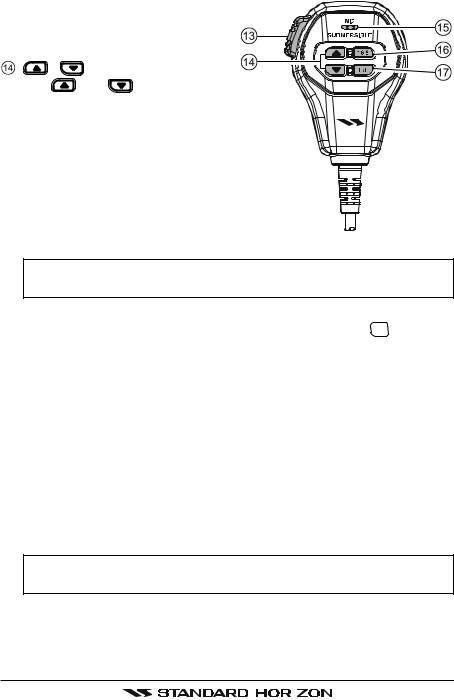Standard horizon ECLIPSE DSC + Owner Manual

ECLIPSE DSC+ GX1150
25 Watt VHF/FM
Class D DSC Marine Transceiver
Owner's Manual
Replaces older Eclipse+ and Eclipse DSC Models
Meets ITU-R M493-12 regulation
16/9, H/L and channel keys on the mic
DSC test call
Auto DSC channel change selection
Full dot matrix display
Submersible JIS-7 / IPX7 (3.3 feet for 30 minutes)
NMEA 0183 Input and Output
Time and GPS position information shown on display*
Programmable Scan, Priority Scan, and Dual Watch
NOAA Weather Channels with Alert
All USA/International and Canadian Marine Channels
3 Year Waterproof Warranty
When GPS connected
GX1150 |
Page 1 |
|
|

TABLE OF CONTENTS
QUICK REFERENCE GUIDE ..................................................................................... |
4 |
|||
1 |
GENERAL INFORMATION ................................................................................... |
6 |
||
2 |
ON-LINE WARRANTY REGISTRATION (in USA or Canada only) .................... |
6 |
||
3 |
PACKING LIST ..................................................................................................... |
|
7 |
|
4 |
OPTIONS .............................................................................................................. |
|
7 |
|
5 |
SAFETY / WARNING INFORMATION .................................................................. |
7 |
||
6 |
FCC RADIO LICENSE INFORMATION ................................................................ |
8 |
||
7 |
FCC NOTICE ........................................................................................................ |
|
9 |
|
8 |
GETTING STARTED |
........................................................................................... |
10 |
|
|
8.1 |
ABOUT VHF RADIO ............................................................................... |
10 |
|
|
8.2 |
SELECTING AN ANTENNA .................................................................... |
10 |
|
|
8.3 |
COAXIAL CABLE ..................................................................................... |
11 |
|
|
8.4 |
EMERGENCY (CHANNEL 16 USE) ......................................................... |
12 |
|
|
8.5 |
CALLING ANOTHER VESSEL (CHANNEL 16 OR 9) ............................. |
12 |
|
|
8.6 |
MAKING TELEPHONE CALLS ............................................................... |
13 |
|
|
8.7 |
OPERATING ON CHANNELS 13 AND 67 ........................................... |
13 |
|
9 |
INSTALLATION ................................................................................................... |
|
14 |
|
|
9.1 |
LOCATION ................................................................................................ |
|
14 |
|
9.2 |
MOUNTING THE RADIO ........................................................................ |
14 |
|
|
|
9.2.1 Supplied Mounting Bracket ............................................................. |
14 |
|
|
|
9.2.2 Optional MMB-84 Flush Mount Bracket ...................................... |
15 |
|
|
9.3 |
ELECTRICAL CONNECTIONS ................................................................ |
16 |
|
|
9.4 |
ACCESSORY CABLE .............................................................................. |
17 |
|
|
9.5 |
CHECKING GPS CONNECTIONS ......................................................... |
17 |
|
|
9.6 |
CHANGING THE GPS TIME .................................................................. |
18 |
|
|
9.7 |
CHANGING THE TIME LOCATION ....................................................... |
19 |
|
10 |
CONTROLS AND INDICATORS ......................................................................... |
20 |
||
11 |
BASIC OPERATION |
........................................................................................... |
24 |
|
|
11.1 |
RECEPTION ............................................................................................. |
|
24 |
|
11.2 |
TRANSMISSION ....................................................................................... |
24 |
|
|
11.3 |
TRANSMIT TIME-OUT TIMER (TOT) ..................................................... |
24 |
|
|
11.4 |
SIMPLEX / DUPLEX CHANNEL USE ..................................................... |
25 |
|
|
11.5 |
INTERNATIONAL, USA, AND CANADA MODE ................................... |
25 |
|
|
11.6 |
NOAA WEATHER CHANNELS ................................................................. |
25 |
|
|
|
11.6.1 NOAA Weather Alert ...................................................................... |
25 |
|
|
|
11.6.2 NOAA Weather Alert Test .............................................................. |
26 |
|
|
11.7 |
SCANNING ............................................................................................... |
|
26 |
|
|
11.7.1 Selecting the Scan Type ................................................................ |
26 |
|
|
|
11.7.2 Memory Scanning (M-SCAN) ........................................................ |
27 |
|
|
|
11.7.3 Priority |
Scanning (P-SCAN) .......................................................... |
28 |
|
|
11.7.4 Priority |
Channel Setting ............................................................... |
28 |
|
|
11.7.5 Dual Watch .................................................................................... |
29 |
|
Page 2 |
|
GX1150 |
|

TABLE OF CONTENTS
12 DIGITAL SELECTIVE CALLING......................................................................... |
|
30 |
|
12.1 |
GENERAL ................................................................................................. |
|
30 |
12.2 |
MARITIME MOBILE SERVICE IDENTITY (MMSI) .................................... |
30 |
|
|
12.2.1 What is an MMSI? ......................................................................... |
|
30 |
|
12.2.2 Programming the MMSI ............................................................... |
31 |
|
12.3 |
DISTRESS ALERT ................................................................................... |
|
32 |
|
12.3.1 Transmitting a Distress Alert ...................................................... |
32 |
|
|
12.3.2 Receiving a Distress Alert .......................................................... |
34 |
|
12.4 |
ALL SHIPS CALL .................................................................................... |
|
35 |
|
12.4.1 Transmitting an All Ships Call ................................................... |
35 |
|
|
12.4.2 Receiving an All Ships Call ....................................................... |
36 |
|
12.5 |
INDIVIDUAL CALL ................................................................................... |
|
37 |
|
12.5.1 |
Setting up the Individual / Position Call Directory .................... |
37 |
|
12.5.2 Setting up Individual Reply ........................................................ |
38 |
|
|
12.5.3 |
Setting Up the Individual Acknowledge Message ................... |
39 |
|
12.5.4 Setting up Individual Call Ringer .............................................. |
40 |
|
|
12.5.5 Transmitting an Individual Call................................................... |
41 |
|
|
12.5.6 Receiving an Individual Call ...................................................... |
43 |
|
12.6 |
CALL WAITING DIRECTORY ................................................................. |
44 |
|
|
12.6.1 |
the Call Waiting Feature .......................... |
44 |
|
12.6.2 |
Calls Logged |
|
|
|
into the Call Waiting Directory .......................... |
44 |
|
12.6.3 Deleting DSC Log Calls ............................................................. |
45 |
|
12.7 |
GROUP CALL .......................................................................................... |
|
46 |
|
12.7.1 Setting up a Group Call ............................................................ |
46 |
|
|
12.7.2 Transmitting a Group Call .......................................................... |
47 |
|
|
12.7.3 Receiving a Group Call .............................................................. |
49 |
|
|
12.7.4 Setting up Group Call Ringer.................................................... |
50 |
|
12.8 |
POSITION REQUEST .............................................................................. |
|
51 |
|
12.8.1 |
Setting up the Position Reply .................................................... |
51 |
|
12.8.2 Transmitting a Position Request to Another Vessel................ |
52 |
|
|
12.8.3 Receiving a Position Request.................................................... |
54 |
|
12.9 |
POSITION REPORT ................................................................................ |
|
55 |
|
12.9.1 Setting up Position Report Ringer ............................................ |
55 |
|
|
12.9.2 Transmitting a DSC Position Report Call ................................ |
56 |
|
|
12.9.3 Receiving a DSC Position Report Call .................................... |
57 |
|
12.10 |
DSC TRANSMISSION TEST .................................................................. |
58 |
|
12.11 MANUAL INPUTTING OF THE GPS LOCATION (LAT/LON) .............. |
59 |
||
13 RADIO SETUP .................................................................................................... |
|
60 |
|
13.1 |
LAMP ADJUSTING .................................................................................. |
|
60 |
13.2 |
LCD CONTRAST ..................................................................................... |
|
60 |
13.3 |
TIME OFFSET.......................................................................................... |
|
61 |
13.4 |
TIME DISPLAY .......................................................................................... |
|
62 |
13.5 |
PRIORITY CHANNEL SET ..................................................................... |
|
62 |
13.6 |
SCAN TYPE ............................................................................................. |
|
63 |
13.7 |
KEY BEEP (ON/OFF) .............................................................................. |
|
63 |
13.8 |
WX ALERT ................................................................................................ |
|
64 |
14 MAINTENANCE .................................................................................................. |
|
65 |
|
14.1 |
REPLACEMENT PARTS .......................................................................... |
|
65 |
14.2 |
FACTORY SERVICE ................................................................................ |
|
66 |
14.3 |
TROUBLESHOOTING CHART ................................................................ |
66 |
|
15 CHANNEL ASSIGNMENTS ................................................................................ |
|
67 |
|
16 WARRANTY |
|
73 |
|
17 SPECIFICATIONS............................................................................................... |
|
76 |
|
|
|
|
|
GX1150 |
|
|
Page 3 |
|
|
||

QUICK REFERENCE GUIDE I
|
CHANNEL SELECT BUTTONS |
|
|
|
|
POWER SWITCH / VOL KNOB |
|
|||||||||
|
|
|
|
|
|
|||||||||||
|
|
|
Turn the transceiver on and off, and |
|||||||||||||
|
|
|
||||||||||||||
Selects the operating channel. |
|
adjust the audio level. |
||||||||||||||
|
|
|
|
|
|
|
|
|
|
|
|
|
|
|
|
|
|
|
|
|
|
|
|
|
|
|
|
|
|
|
|
|
|
|
|
|
|
|
|
|
|
|
|
|
|
|
|
|
|
|
|
|
|
|
|
|
|
|
|
|
|
|
|
|
|
|
|
|
|
|
|
|
|
|
|
|
|
|
|
|
|
|
|
|
|
|
|
|
|
|
|
|
|
|
|
|
|
|
|
|
|
|
|
|
|
|
|
|
|
|
|
|
|
|
|
|
|
|
16/9 BUTTON
Press to recall channel 16.
Press and hold to recall channel 9.
Press again to revert to the last selected channel.
TRANSMISSION
SWITCH
Speak into the microphone in a normal voice level while pressing this switch.
CHANNEL SELECT
BUTTONS
Selects the operating channel.
SQL KNOB
Move this control clockwise to squelch or counter clockwise unsquelch the radio.
MIC HOLE
Be sure your mouth is about 1/2 inch (1.3 cm) from the mic hole for best performance.
H/L BUTTON
W h e n p r e s s e d , toggles the transmit power between High
(25W) and Low (1W).
Page 4 |
|
GX1150 |
|

QUICK REFERENCE GUIDE II
CHANNEL SELECT BUTTONS
Press to select a VHF or WX channel.
Used to select a desired channel and to select items in the DSC OPERATION and SETUP menus.
DISTRESS BUTTON
Note: for this key to operate a MMSI must be programmed.
Lift the red cover, press the Distress button once, then press and hold until the radio alarms.
CLR / WX BUTTON
Press to cancel the menu selection.
Press and hold to recall the lastused NOAA Weather Channel.
ENT BUTTON
When Radio or DSC menus are selected, pressing this key saves a selection.
SCAN / MEM BUTTON
Press and hold to save or remove a channel from scan memory.
Press to start and stop the scanning of programmed channels.
CALL / MENU BUTTON
Press to access the “DSC MENU”.
Press and hold to access the Radio and DSC setup menus.
GX1150 |
|
Page 5 |
|

1 GENERAL INFORMATION
The GX1150 ECLIPSE DSC+ is a VHF/FM transceiver designed for use in the frequency range of 156.025 to 163.275 MHz. The GX1150 can be operated from 11 to 16 VDC and has a switchable RF output power of 1 watt or 25 watts.
The GX1150 is capable of DSC (Digital Selective Calling) Class D (independent Channel 70 receiver) operation which allows continuous receiving of Digital Selective Calling functions on channel 70 even if the radio is receiving a call.
The GX1150 operates on all currently-allocated marine channels which are switchable for use with either USA, International, or Canadian regulations. It has an emergency channel 16 which can be immediately selected from any channel by pressing the red  key. NOAA Weather channels can also be accessed immediately by pressing and holding the
key. NOAA Weather channels can also be accessed immediately by pressing and holding the  key.
key.
Other features of the transceiver include: scanning, priority scanning, submersible mic, high and low voltage warning, and GPS repeatability.
2ON-LINE WARRANTY REGISTRATION (in USA or Canada only)
Please visit www.standardhorizon.com to register the GX1150 Marine VHF. It should be noted that visiting the Web site from time to time may be beneficial to you, as new products are released they will appear on the Marine Division of Vertex Standard Web site.
PRODUCT SUPPORT INQUIRIES
If you have any questions or comments regarding the use of the GX1150, you can visit the Marine Division of Vertex Standard Web site to send an E-Mail or contact the Product Support team at (800) 767-2450 M-F 7:00AM to 5:00PM PST.
Page 6 |
|
GX1150 |
|

3 PACKING LIST
When the package containing the transceiver is first opened, please check it for the following contents:
GX1150 Transceiver
Mounting Bracket and hardware
Power Cord with 6 Amp fuse and holder
Owner’s Manual
Warranty Card
4 OPTIONS
MMB-84 |
......................................................................... Flush-Mount Bracket |
MLS-310 .............................................................. |
Amplified External Speaker |
MLS-300 ...................................................................... |
External Loudspeaker |
5 SAFETY / WARNING INFORMATION
This radio is restricted to occupational use, work related operations only where the radio operator must have the knowledge to control the exposure conditions of its passengers and bystanders by maintaining the minimum separation distance of 0.6 m (2 feet).
Failure to observe these restrictions will result in exceeding the FCC RF exposure limits.
Antenna Installation:
The antenna must be located at least 0.6 m (2 feet) away from passengers in order to comply with the FCC RF exposure requirements.
GX1150 |
|
Page 7 |
|

6 FCC RADIO LICENSE INFORMATION
Standard Horizon radios comply with the Federal Communication Commission
(FCC) requirements that regulate the Maritime Radio Service.
STATION LICENSE
An FCC ship station license is no longer required for any vessel traveling in
U.S. waters (except Hawaii) which is under 20 meters in length. However, any vessel required to carry a marine radio on an international voyage, carrying a HF single side band radiotelephone or marine satellite terminal is required to have a ship station license. FCC license forms, including applications for ship
(605) and land station licenses can be downloaded via the Internet at http://www.fcc.gov/Forms/Form605/605.html. To obtain a form from the FCC, call (888) 225-5322.
RADIO CALL SIGN
Currently the FCC does not require recreational boaters to have a Ship Radio
Station License. The USCG recommends the boats registration number and the state to be used.
CANADIAN SHIP STATION LICENSING
You may need a license when traveling in Canada. If you do need a license contact their nearest field office or regional office or write:
Industry Canada
Radio Regulatory Branch
Attn: DOSP
300 Slater Street
Ottawa, Ontario
Canada, KIA 0C8
FCC / INDUSTRY CANADA INFORMATION
The following data pertaining to the transceiver is necessary to fill out the license application.
Type Acceptance ......................................................................... |
FCC Part 80 |
Output Power ............................................... |
1 Watt (low) and 25 Watts (high) |
Emission ......................................................................... |
16K0G3E, 16K0G2B |
Frequency Range ..................................................... |
156.025 to 163.275 MHz |
FCC Type Number.................................................................... |
K6630373X3D |
Industry Canada Type Approval ............................................. |
511B-30373X3S |
Page 8 |
|
GX1150 |
|

7 FCC NOTICE
NOTICE
Unauthorized changes or modifications to this equipment may void compliance with FCC Rules. Any change or modification must be approved in writing by Standard Horizon.
NOTICE
This equipment has been tested and found to comply with the limits for a
Class B digital device, pursuant to Part 15 of the FCC Rules. These limits are designed to provide reasonable protection against harmful interference in a residential installation. This equipment generates, uses and can radiate radio frequency energy and, if not installed and used in accordance with the instructions, may cause harmful interference to radio communications. However, there is no guarantee that interference will not occur in a particular installation. If this equipment does cause harmful interference to radio or television reception, which can be determined by turning the equipment off and on, the user is encouraged to try to correct the interference by one or more of the following measures:
-Reorient or relocate the receiving antenna.
-Increase the separation between the equipment and receiver.
-Connect the equipment into an outlet on a circuit different from that to which the receiver is connected.
-Consult the dealer or an experienced radio/TV technician for help.
GX1150 |
|
Page 9 |
|

8 GETTING STARTED
8.1 ABOUT VHF RADIO
The radio frequencies used in the VHF marine band lie between 156 and 158
MHz with some shore stations available between 161 and 163 MHz. The marine VHF band provides communications over distances that are essentially “line of sight” (VHF signals do not travel well through objects such as buildings, hills or trees). Actual transmission range depends much more on antenna type, gain and height than on the power output of the transmitter. On a fixed mount 25W radio transmission expected distances can be greater than 15 miles.
8.2 SELECTING AN ANTENNA
Marine antennas are made to radiate signals equally in all horizontal directions, but not straight up. The objective of a marine antenna is to enhance the signal toward the horizon. The degree to which this is accomplished is called the antenna’s gain. It is measured in decibels (dB) and is one of the major factors in choosing an antenna. In terms of effective radiated power (ERP), antennas are rated on the basis of how much gain they have over a theoretical antenna with zero gain. A 3 foot, 3dB gain antenna represents twice as much gain over the imaginary antenna.
Typically a 3 foot 3dB gain stainless steel whip is used on a sailboat mast. The longer 8 foot 6dB fiberglass whip is primarily used on power boats that require the additional gain.
3dB
6dB
9dB
Page 10 |
|
GX1150 |
|

8.3 COAXIAL CABLE
VHF antennas are connected to the transceiver by means of a coaxial cable – a shielded transmission line. Coaxial cable is specified by it’s diameter and construction.
For runs less than 20 feet, RG-58/U, about 1/4 inch in diameter is a good choice. For runs over 20 feet but less than 50 feet, the larger RG-8X should be used.
For cable runs over 50 feet RG-213 should be used. For installation of the connector onto the coaxial cable refer to the figure below.
To get your coax cable through a fitting and into your boat’s interior, you may have to cut off the end plug and reattach it later. You can do this if you follow the directions that are supplied with the connector. Be sure to make good soldered connections.
GX1150 |
|
Page 11 |
|

8.4 EMERGENCY (CHANNEL 16 USE)
Channel 16 is known as the Hail and Distress Channel. An emergency is defined as a threat to life or property. In such instances, be sure the transceiver is on and set to CHANNEL 16. Then use the following procedure:
1. |
Press the microphone push-to-talk switch and say “Mayday, Mayday, May- |
||||||||
|
day. This is |
|
, |
|
, |
|
|
” (your vessel’s name). |
|
2. |
Then repeat once: “Mayday, |
|
|
” (your vessel’s name). |
|||||
3.Now report your position in latitude/longitude, or by giving a true or magnetic bearing (state which) to a well-known landmark such as a navigation aid or geographic feature such as an island or harbour entry.
4.Explain the nature of your distress (sinking, collision, aground, fire, heart attack, life-threatening injury, etc.).
5.State the kind of assistance you desire (pumps, medical aid, etc.).
6.Report the number of persons aboard and condition of any injured.
7.Estimate the present seaworthiness and condition of your vessel.
8.Give your vessel’s description: length, design (power or sail), color and other distinguishing marks. The total transmission should not exceed 1 minute.
9.End the message by saying “OVER.” Release the microphone button and listen.
10.If there is no answer, repeat the above procedure. If there is still no response, try another channel.
8.5 CALLING ANOTHER VESSEL (CHANNEL 16 OR 9)
Channel 16 may be used for initial contact (hailing) with another vessel.
However, its most important use is for emergency messages. This channel must be monitored at all times except when actually using another channel.
It is monitored by the European, U.S. and Canadian Coast Guards and by other vessels. Use of channel 16 for hailing must be limited to initial contact only. Calling should not exceed 30 seconds, but may be repeated 3 times at 2- minute intervals. In areas of heavy radio traffic, congestion on channel 16 resulting from its use as a hailing channel can be reduced significantly in U.S. waters by using channel 9 as the initial contact (hailing) channel for non-emer- gency communications. Here, also, calling time should not exceed 30 seconds but may be repeated 3 times at 2-minute intervals.
Prior to making contact with another vessel, refer to the channel charts in this manual, and select an appropriate channel for communications after initial contact. For example, Channels 68 and 69 are some of the channels available to non-commercial (recreational) boaters. Monitor your desired channel in advance to make sure you will not be interrupting other traffic, and then go back to either
Page 12 |
|
GX1150 |
|

channel 16 or 9 for your initial contact.
When the hailing channel (16 or 9) is clear, state the name of the other vessel you wish to call and then “this is” followed by the name of your vessel and your
Station License (Call Sign). When the other vessel returns your call, immediately request another channel by saying “go to,” the number of the other channel, and “over.” Then switch to the new channel. When the new channel is not busy, call the other vessel.
After a transmission, say “over,” and release the microphone’s push-to-talk (PTT) switch. When all communication with the other vessel is completed, end the last transmission by stating your Call Sign and the word “out.” Note that it is not necessary to state your Call Sign with each transmission, only at the beginning and end of the contact.
Remember to return to Channel 16 when not using another channel. Some radios automatically monitor Channel 16 even when set to other channels or when scanning.
8.6 MAKING TELEPHONE CALLS
To make a radiotelephone call, use a channel designated for this purpose, The fastest way to learn which channels are used for radiotelephone traffic is to ask at a local marina. Channels available for such traffic are designated Public
Correspondence channels on the channel charts in this manual. Some examples for USA use are Channels 24, 25, 26, 27, 28, 84, 85, 86, and 87. Call the marine operator and identify yourself by your vessel’s name, The marine operator will then ask you how you will pay for the call (telephone credit card, collect, etc.) and then link your radio transmission to the telephone lines.
The marine telephone company managing the VHF channel you are using may charge a link-up fee in addition to the cost of the call.
8.7 OPERATING ON CHANNELS 13 AND 67
Channel 13 is used at docks and bridges and by vessels manoeuvering in port.
Messages on this channel must concern navigation only, such as meeting and passing in restricted waters.
Channel 67 is used for navigational traffic between vessels.
By regulation, power is normally limited to 1 Watt on these channels. Your radio is programmed to automatically reduce power to this limit on these channels. However, in certain situations it may be necessary to temporarily use a higher power. See page 23 ( key) for means to temporarily override the low-power limit on these two channels.
key) for means to temporarily override the low-power limit on these two channels.
GX1150 |
|
Page 13 |
|

9 INSTALLATION
9.1 LOCATION
The radio can be mounted at any angle. Choose a mounting location that:
•keeps the radio and microphone at least 3.3 ft (1 m) away from your vessel’s magnetic navigation compass
•provides accessibility to the front panel controls
•allows connection to a power source and an antenna
•has nearby space for installation of a microphone hanger
•the antenna must be mounted at least 3.3 ft (1 m) from radio
Note: To insure the radio does not affect the compass, or that the radios performance is not affected by the antenna location, temporarily connect the radio in the desired location and:
a.Examine the compass to see if the radio causes any deviation
b.Connect the antenna and key the radio. Check to ensure the radio is operating correctly by requesting a radio check.
9.2MOUNTING THE RADIO
9.2.1 Supplied Mounting Bracket
The supplied mounting bracket allows overhead or desktop mounting.
Use a 13/64” (5.2-mm) bit to drill the holes to a surface which is more 0.4 inch
(10 mm) thick and can support more than 3.3 lbs (1.5 kg). Secure the bracket with the supplied screws, spring washers, flat washers, and nuts.
|
|
|
|
|
|
|
|
|
|
|
|
|
|
|
|
|
|
|
|
|
|
|
|
|
|
|
|
|
|
|
|
|
|
|
|
|
|
|
|
|
|
|
|
|
|
|
|
|
|
|
|
|
|
|
|
|
|
|
|
|
|
|
|
|
|
|
|
|
|
|
|
|
|
|
|
|
|
|
|
|
|
|
|
|
|
|
|
|
|
|
|
|
|
|
|
|
|
|
|
|
|
|
|
|
|
|
|
|
|
|
|
|
|
|
|
|
|
|
|
|
|
|
|
|
|
|
|
|
|
|
|
|
|
|
|
|
|
|
|
|
|
|
|
|
|
|
|
|
|
|
|
|
|
|
|
|
|
|
|
|
|
|
|
|
|
|
|
|
|
|
|
|
|
|
|
|
|
|
|
|
|
|
|
|
|
|
|
|
|
|
|
|
|
|
|
|
|
|
|
|
|
|
|
|
|
|
|
|
|
|
|
|
|
|
|
|
|
|
|
|
|
|
|
|
|
|
|
|
|
|
|
|
|
|
|
|
|
|
|
|
|
|
|
|
|
|
|
|
|
|
|
|
|
|
|
|
|
|
|
|
|
|
|
|
|
|
|
|
|
|
|
|
|
|
|
|
|
|
|
|
|
|
|
|
|
|
|
|
|
|
|
|
|
|
|
|
|
|
|
|
|
|
|
|
|
|
|
|
|
|
|
|
|
|
|
|
|
|
|
|
|
|
|
|
|
|
|
|
|
|
|
|
|
|
|
|
|
|
|
|
|
Desktop Mounting |
Overhead Mounting |
|||||||
|
|
|
|
|
|
|
|
|
Page 14 |
|
|
|
|
GX1150 |
|||
|
||||||||

9.2.2 Optional MMB-84 Flush Mount Bracket
1.To assist in flush mounting, a template has been included. Use this template to assess the mounting location.
2.Use the template to mark the location where the rectangular hole is to be cut. Confirm the space behind the dash or panel is deep enough to accommodate the transceiver (at least 6.7 inches or 17 cm deep).
There should be at least 1/2 inch (1.3 cm) between the transceiver’s heatsink and any wiring, cables or structures.
3.Cut out the rectangular hole and insert the transceiver.
4.Fasten the brackets to the sides of the transceiver with the lock washer nut combination, so that the mounting screw base faces the mounting surface.
5.Turn the adjusting screw to adjust the tension so that the transceiver is tight against the mounting surface.
Bracket
Adjusting Screw
Lock-washer nut combination
MMB-84 Flush Mount Installation
GX1150 |
|
Page 15 |
|

9.3 ELECTRICAL CONNECTIONS
CAUTION
Reverse polarity connections will damage the radio!
Connect the power cord and antenna to the radio. Antenna and Power Supply connections are as follows (see Figure 1):
1.Mount the antenna at least 1 m away from the radio. At the rear of the radio, connect the antenna cable.
2.Connect the red power wire to a 13.8 VDC ±20% power source. Connect the black power wire to a negative ground.
3.If an optional remote extension speaker is to be used, refer to next section for connections.
4.It is advisable to have a Certified Marine Technician check the power output and the standing wave ratio of the antenna after installation.
Optional Speaker
GPS Navigation Receiver
Antenna
Accessory Cable
Water proof
Deck Outlet
Fuse
Red Black
Power Source
Figure 1. General Installation
Fuse Replacement
To take out the Fuse from the Fuse Holder, hold
both ends of the Fuse Holder and pull the Fuse 





 Holder apart, do not bend the Fuse Holder. When
Holder apart, do not bend the Fuse Holder. When 


you replace the Fuse, please confirm that the Fuse is tightly fixed on the metal contact located inside 





 the Fuse Holder. If the metal contact holding the
the Fuse Holder. If the metal contact holding the 





 fuse is loose, the Fuse holder may heat up.
fuse is loose, the Fuse holder may heat up. 

Page 16 |
|
GX1150 |
|

9.4 ACCESSORY CABLE
Wire Color/Description |
Connection Examples |
WHITE - External Speaker (+) |
Connect to external 4 Ohm audio speaker |
SHIELD - External Speaker (–) |
Connect to external 4 Ohm audio speaker |
BLUENMEA Input (+) |
Connect to NMEA (+) output of GPS |
GREEN - NMEA Common or Ground |
Connect to NMEA ground of GPS |
PURPLE - NMEA Output (+) |
Connect to NMEA (+) input of GPS |
When connecting the external speaker or GPS navigation receiver, strip off about 1 inch (2.5 cm) of the specified wire’s insulation, then splice the ends together using proper waterproofing techniques.
|
PA Speaker |
Shield |
GPS Receiver |
White |
|
Purple |
NMEA IN ( ) |
Green |
NMEA COMMON ( ) |
Blue |
NMEA OUT ( ) |
Radio Wires |
Plotter Connection |
•The GPS must have the NMEA Output turned on and set to 4800 Baud in the setup menu. If there is a selection for parity select none.
•For further information on interfacing /setting up your GPS. Please contact the manufacturer of the GPS receiver.
•GX1150 can read NMEA-0183 version 2.0 or higher.
•The NMEA supported sentences are:
Input: GLL, GGA, RMC and GNS (RMC sentence is recommended)
Output: DSC and DSE
9.5 CHECKING GPS CONNECTIONS
After connections have been made between the 



GX1150 and the GPS, a small satellite icon will appear on the top right corner of the display, and displays your current location (Latitude/Longitude) on the display.
NOTE
•If there is a problem with the NMEA input from a GPS, the satellite icon will blink continuously until the connection is corrected.
•If a GPS with NMEA output is not connected to the radio, the GX1150 will beep 10 minutes after the radio is turned on. After that the GX1150 will beep every 4 hours alerting to connect a GPS.
GX1150 |
|
Page 17 |
|

9.6 CHANGING THE GPS TIME
From the Factory the GX1150 shows GPS satellite time or UTC time. A time offset is needed to show the local time in your area.
1. |
Press and hold down the |
key until “SETUP |
|||
|
MENU” appears. |
|
|
||
2. |
Press the |
key, then select “TIME OFFSET” with |
|||
|
the |
/ |
keys. |
|
|
3. |
Press the |
key. |
|
|
|
4. |
Press the |
/ |
keys to select time offset from |
||
|
UTC. See illustration below to find your offset time |
||||
|
from UTC. If “00:00” is assigned, the time is the |
||||
|
same as UTC (Universal Time Coordinated or |
||||
|
GMT Greenwich Mean Time). |
|
|||
5. |
Press the |
key to store the time offset. |
|||
6. |
Press the |
key to exit the menu mode and re- |
|||
turn to radio operation.
OFFSET TIME TABLE
Page 18 |
|
GX1150 |
|

9.7 CHANGING THE TIME LOCATION
This menu item allows you to choose to show UTC or the local time which is selected in Section 9.6.
1. |
Press and hold down the |
key until “SETUP |
|||
|
MENU” appears. |
|
|
||
2. |
Press the |
key, then select “TIME DISPLAY” with |
|||
|
the |
/ |
keys. |
|
|
3. |
Press the |
key. |
|
|
|
4. |
Press the |
/ |
to select “UTC” or “LOCAL”. |
||
5. |
Press the |
key to store the selected setting. |
|||
6. |
Press the |
key to exit the menu mode and re- |
|||
turn to radio operation.
In the Local time mode, the display shows the time by the 12-hour system. Meanwhile, the display shows the time by 24-hour system in the UTC time mode.
(“UTC” mode) |
(“LOCAL” mode) |
GX1150 |
|
Page 19 |
|

10 CONTROLS AND INDICATORS
Front Panel
 POWER SWITCH / VOLUME CONTROL (VOL/PWR)
POWER SWITCH / VOLUME CONTROL (VOL/PWR)
Turns the transceiver on and off as well as adjusts the audio volume. Turn this knob clockwise to turn the radio on and to increase the speakers audio volume level.
Turn fully counter-clockwise to turn the radio off.
 SQUELCH CONTROL (SQL)
SQUELCH CONTROL (SQL)
Adjusting this control clockwise, sets the point at which random noise on the channel does not activate the audio circuits but a received signal will.
This point is called the squelch threshold. Further adjustment of the squelch control will degrade reception of wanted transmissions.

 Key
Key
Press the  key to cancel the menu selection.
key to cancel the menu selection.
Secondary use
Press and hold the |
|
key to recall the last-used NOAA (National Oceanic |
and Atmospheric Administration) Weather Channel from any channel location. Recalls the previously-selected working channel when you press and
hold the |
key again. |
Key |
|
Press the |
Key to determine the menu selection. |
Page 20 |
|
GX1150 |
|

Key |
|
Press the |
key to access the “DSC MENU”. The “INDIVIDUAL CALL”, |
“GROUP CALL”, “ALL SHIPS CALL”, “POS REQUEST”, “POS REPORT”, “DSC LOG”, and “DSC TEST” functions can be accessed from the “DSC MENU”.
NOTE
Before the “DSC MENU” menu can be selected a MMSI must be entered. Refer to section “12.2 MARITIME MOBILE SERVICE IDENTITY (MMSI).”
Secondary use
Press and hold the  key to access the “SETUP MENU”. The “RADIO SETUP”
key to access the “SETUP MENU”. The “RADIO SETUP”
(refer to section “13 RADIO SETUP”), “DSC SETUP”, “POS INPUT”, and “MMSI SETUP” functions can be accessed from the “SETUP MENU”.
 KEYPAD
KEYPAD
 /
/  Keys
Keys
The  and
and  keys are used to select a desired channel and to select items in the DSC OPERATION and SETUP menus.
keys are used to select a desired channel and to select items in the DSC OPERATION and SETUP menus.
 Key
Key
Immediately recalls channel 16 from any channel location and automatically selects high power. Holding down this key recalls channel 9. Pressing the  key again reverts to the previous selected working channel.
key again reverts to the previous selected working channel.
Secondary use
Press and hold the  key then press the
key then press the  key to switch between the
key to switch between the
USA, Canadian, and International Channel Groups.
 Key
Key
Press this key to start and stop the scanning of programmed channels. Refer to section “11.7 SCANNING” for details.
Secondary use
To add a channel into the scan memory, select the channel and press and hold the  key until “MEM” is shown on the display.
key until “MEM” is shown on the display.
To delete a memorized channel from scan memory, select the channel and press and hold the  key until “MEM” is removed from the display.
key until “MEM” is removed from the display.
 [DISTRESS] Key
[DISTRESS] Key
Used to send a DSC Distress Call. To send the distress call refer to section “12.3.1 Transmitting a Distress Alert”.
GX1150 |
|
Page 21 |
|

Rear Panel
 DC INPUT CABLE
DC INPUT CABLE
Connects the radio to a DC power supply capable of delivering 12V DC.
 EXTERNAL SPEAKER CONNECTION CABLE
EXTERNAL SPEAKER CONNECTION CABLE
Connects the GX1150 to an external speaker.
 GPS RECEIVER CONNECTION CABLE
GPS RECEIVER CONNECTION CABLE
Connects the GX1150 to a GPS receiver.
 GND TERMINAL
GND TERMINAL
Connects the GX1150 to a good ground, for safety and optimum performance.
Normally, the GND connection to the heat sink is not needed. However, when the DC power cable connection to the radio has a long run, the transmitter may become unstable and the receiving audio may be noisy. In such a case, connect a large diameter, short cable between this terminal on the heat sink and battery ground.
Install only the supplied screw or similar size (M3x6, Stainless Steel) screw.
 ANTENNA JACK
ANTENNA JACK
Connects an antenna to the transceiver. Use a marine VHF antenna with an impedance of 50 ohms.
Page 22 |
|
GX1150 |
|

Microphone
 PTT (Push-To-Talk) SWITCH
PTT (Push-To-Talk) SWITCH
Keys the transmitter when the transceiver is in radio mode.
/ |
KEYS |
|
The |
and |
keys on the mi- |
crophone function the same as the  and
and  keys on the front panel of the transceiver.
keys on the front panel of the transceiver.
 MICROPHONE
MICROPHONE
Transmits the voice message with reduction of background noise, using Clear Voice Noise Reduction
Technology.
NOTE
Be sure your mouth is about 1/2 inch (1.3 cm) from the mic hole for best performance.

 Key
Key
The  key on the microphone functions the same as the
key on the microphone functions the same as the  key on the front panel of the transceiver.
key on the front panel of the transceiver.
Immediately recalls channel 16 from any channel location. Holding down this key recalls channel 9. Pressing the  key again reverts to the previously selected working channel.
key again reverts to the previously selected working channel.

 Key
Key
Press this key to toggle the transmit output power between 25 W (High) and 1 W (Low) power. When the  key is pressed while the transceiver is on channel 13 or 67, the power will temporarily switch from LO to HI power until the PTT is released.
key is pressed while the transceiver is on channel 13 or 67, the power will temporarily switch from LO to HI power until the PTT is released.
The  key does not function on transmit inhibited and low power only channels.
key does not function on transmit inhibited and low power only channels.
NOTE
1W low power is indicated by LO on the display. When 25W high power is selected the display do not show an indication.
GX1150 |
|
Page 23 |
|

11BASIC OPERATION
11.1RECEPTION
1.After the GX1150 has been installed, ensure that the power supply and antenna are properly connected.
2.Turn the VOL/PWR knob clockwise to turn the transceiver on.
3.Turn the SQL knob fully counterclockwise. This state is known as “squelch off”.
4.Turn up the VOL knob until noise or audio from the speaker is at a comfortable level.
5.Turn the SQL knob clockwise until the random noise disappears. This state is known as the “squelch threshold.”
6.Press the  or
or  keys to select the desired channel. Refer to the channel chart on page 70 for available channels.
keys to select the desired channel. Refer to the channel chart on page 70 for available channels.
7.When a message is received, adjust the volume to the desired listening level. The “ ” indicator on the LCD is displayed indicating that the channel is being used.
” indicator on the LCD is displayed indicating that the channel is being used.
11.2 TRANSMISSION
1.Perform steps 1 through 6 of RECEPTION.
2.Before transmitting, monitor the channel to ensure it is clear.
THIS IS AN FCC REQUIREMENT!
3Press the PTT (push-to-talk) switch. The “ ” indicator in the LCD is displayed.
” indicator in the LCD is displayed.
4. Speak slowly and clearly into the microphone.
NOTE
This is a noise cancelling microphone. The oval slot on the microphone should be positioned within 1/2 inch (1.3 cm) from the mouth for optimum performance.
5. When the transmission is finished, release the PTT switch.
11.3 TRANSMIT TIME - OUT TIMER (TOT)
When the PTT switch on the microphone is held down, transmit time is limited to 5 minutes. This limits unintentional transmissions due to a stuck microphone.
About 10 seconds before automatic transmitter shutdown, a warning beep will be heard from the speaker(s). The transceiver will automatically go to receive mode, even if the PTT switch is continually held down. Before transmitting again, the PTT switch must first be released and then pressed again.
NOTE
When a transmission was shut down by the TOT, the GX1150 can not transmit afterwards for 10 seconds.
Page 24 |
|
GX1150 |
|
